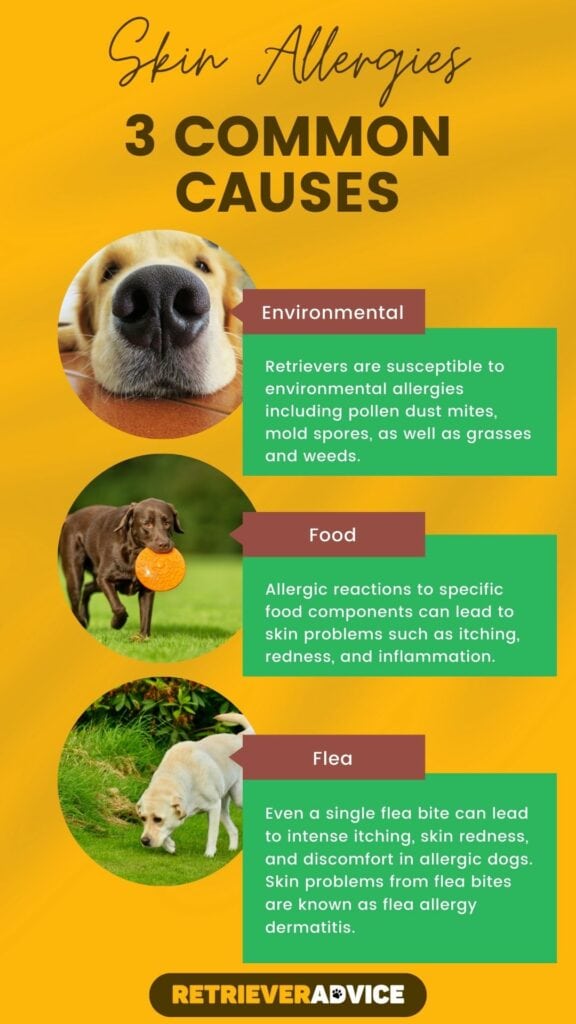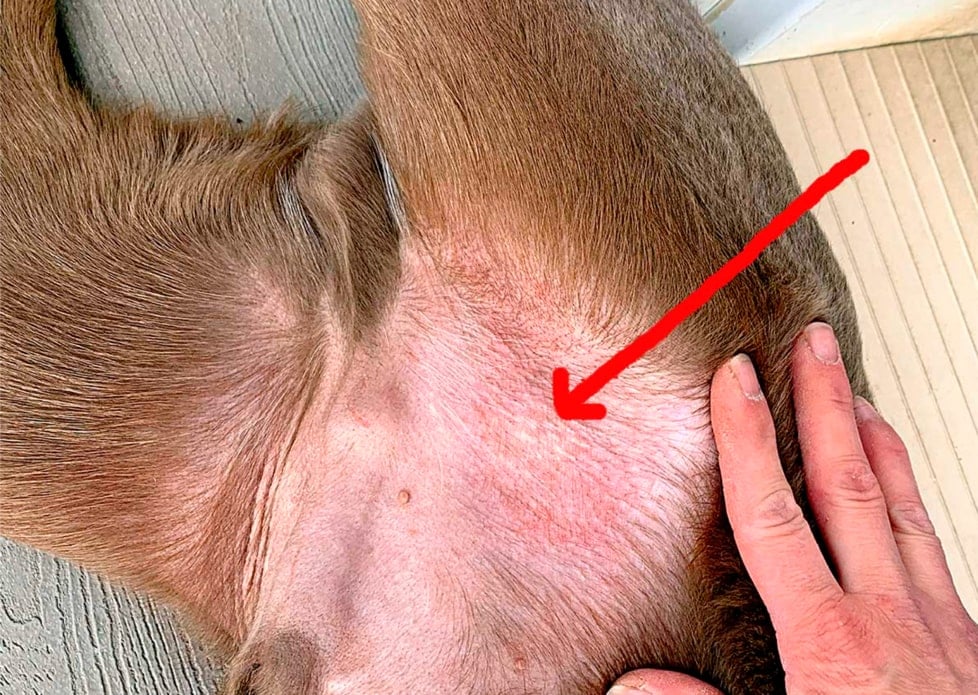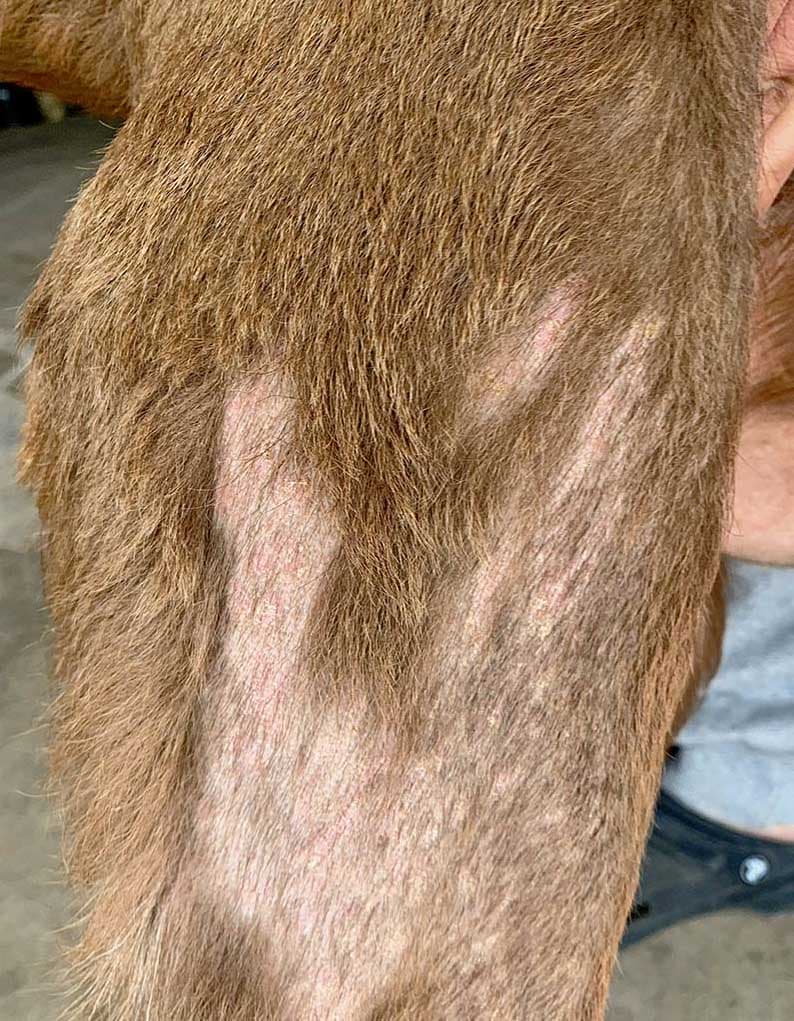Allergic Dermatitis in Dogs: Dash’s Story
Is allergic dermatitis affecting your dog’s well-being? Unpack the symptoms, causes, and treatments in this article as Dr. Wendy Wilkins, DVM, Ph.D., walks us through all of the details.
Allergic Dermatitis in Retriever Dogs: Dash’s Story
Meet Dash, a lively and adorable nine-month-old silver Labrador Retriever. Already in his short life he has experienced health challenges that no one wants to see in their pup.
Dash’s story is not just his own; it reflects the experiences of many Golden and Labrador Retrievers, who are prone to skin allergies.
In this article, we delve into Dash’s story, from onset of his allergy symptoms to diagnosis and management. His story provides insightful perspectives on how dog allergies can be effectively managed.

This account is a guide for pet owners facing similar challenges. It emphasizes the significance of professional veterinary care and personalized management plans to ensure our pups can all live comfortable and happy lives.
Dash’s Story – The Beginning
Dash and his sister, Daisy, joined our daughter’s family when they were 10 weeks old. They were the cutest puppies, full of energy and love.
However, it wasn’t very long until we noticed that Dash’s eyes were always red and he seemed to be scratching himself a bit more than normal.
Dash’s condition slowly worsened as spring progressed and summer approached. Patches of skin became reddened and roughened, and he started to lose hair in those areas. No doubt about it, Dash had developed allergic dermatitis.
After several trips to the vet (me!) and trying a few different treatments, we finally found a solution that worked for him. But before we get into that, let’s learn a bit more about allergic dermatitis in dogs.
What Is Allergic Dermatitis In Dogs
Allergic dermatitis, or canine atopic dermatitis, as the name suggests, is a skin problem that is caused by allergies.
An allergy is an abnormal immune response to a typically harmless substance, called an allergen, which can trigger various symptoms or reactions in the body ranging from mild discomfort to severe responses such as life-threatening anaphylaxis.
A dog that has allergies usually has itchy skin. In fact, itchy skin and ears are some of the most common symptoms of allergies in dogs.
Allergic dermatitis is a skin condition caused by an allergic reaction to various environmental, dietary, or insect-related allergens.
This condition is one of the most prevalent skin disorders in dogs and can cause significant discomfort and distress. Left untreated, it can impact the dog’s health, comfort, and overall quality of life.
Fortunately, allergies in dogs are a fairly well understood topic (unlike allergies in cats!) and, with recent advances in veterinary medicine, there are many treatment options available to help manage allergic dermatitis in dogs.
Dog Breeds Predisposed to Allergies
All dog breeds can potentially develop allergies, but certain breeds are affected more often than others.
This breed-specific susceptibility may be linked to genetics, environmental factors, or a combination of both. Golden and Labrador Retrievers unfortunately rank high in terms of susceptibility to allergies.
These allergies can manifest as skin irritations which lead to allergic dermatitis. Owners of Golden and Labrador Retrievers need to be aware of the signs and symptoms of allergies and allergic dermatitis, and consult their vet for appropriate prevention and treatment strategies.
Some of the other dog breeds known to be prone to allergies and allergic dermatitis include the Bulldog, Bichon Frisé, Pug, Shar Pei, and West Highland Terrier, among others.
What Causes Skin Allergies in Golden And Labrador Retriever Dogs?
The various causes of skin allergies in Golden and Labrador Retriever dogs can generally be categorized into three main groups: environmental, food, and fleas:
- Environmental Allergens:
- Pollen: Both Golden and Labrador Retrievers are susceptible to pollen allergies, which can be inhaled or come into contact with the skin, leading to allergic reactions.
- Dust Mites: These microscopic pests can trigger allergic dermatitis when they are inhaled or come into contact with a dog’s skin.
- Mold Spores: Mold spores in the environment, especially in damp conditions, can lead to skin allergies in these breeds.
- Grasses and Weeds: Exposure to various grasses and weeds, common in outdoor environments, can cause skin irritation and allergic reactions.
- Food Allergies:
- Certain ingredients commonly found in commercial dog foods, such as proteins (e.g., beef, chicken) and grains (e.g., wheat, corn), can trigger food allergies in Golden and Labrador Retrievers.
- Allergic reactions to specific food components can lead to skin problems such as itching, redness, and inflammation.
- Flea Allergies:
- Flea saliva contains proteins that can cause severe allergic reactions in dogs that are sensitive to them, including both Golden and Labrador Retrievers.
- Even a single flea bite can lead to intense itching, skin redness, and discomfort in allergic dogs. Skin problems from flea bites are known as flea allergy dermatitis.

What Are The Symptoms Of Skin Allergies In Golden And Labrador Retrievers?
Golden Retrievers and Labrador Retrievers with skin allergies, like many other dog breeds, can have a range of symptoms. Common symptoms of skin allergies in these breeds include:
- Itching (Pruritus): Persistent itching is one of the most prominent signs of skin allergies in Golden and Labrador Retrievers. Dogs may scratch, chew, lick, or rub their skin excessively. The feet, legs, face, and ears are most commonly affected.
- Redness (Erythema): Allergic reactions often cause the skin to become red and inflamed. This redness can be localized to specific areas such as the armpit or groin area, or may affect larger portions of the dog’s body.
- Skin Inflammation (Dermatitis): Skin allergies can lead to dermatitis, characterized by swollen, irritated skin. Inflamed skin may feel warm to the touch and appear uncomfortable for the dog.
- Skin Lesions: Allergic reactions can result in various skin lesions, including pustules (small pus-filled bumps), papules (raised bumps), and crusts (dry, scaly patches).
- Hair Loss (Alopecia): Dogs with skin allergies may experience hair loss in the affected areas due to constant scratching, licking, or chewing.
- Hot Spots (Acute Moist Dermatitis): Dogs may develop hot spots, which are painful, moist, and red areas of skin that can worsen rapidly due to self-trauma. These are often a result of excessive scratching and licking which damages the skin leading to bacterial infections.
- Ear Infections (Otitis Externa): Skin allergies can extend to the ears, leading to ear infections. Dogs may shake their heads, scratch their ears, or display other signs of discomfort and pain.
- Secondary Infections: Constant scratching and broken skin can create openings for bacterial or yeast infections, which can worsen the symptoms and require additional treatment.
- Rubbing or Scooting: Dogs may rub their bodies against surfaces or scoot their rear ends on the ground as they attempt to scratch their itch. Dogs with allergies are more prone to anal gland problems, which can also lead to scooting.
- Red Paws: If the itchy skin happens to be on their paws, dogs may excessively lick and chew their paws, leading to irritation and secondary infections which cause the skin of the paws to become red and inflamed.
- Changes in Behavior: Skin allergies can make dogs irritable or anxious. They may become restless, have difficulty sleeping, or show changes in appetite.
Your dog may have just one of these symptoms, or they may have a combination. The severity and frequency of the symptoms may also wax and wane, depending on the allergen involved.
For example, dogs with pollen or grass allergies may get worse during the spring and summer but improve significantly during the winter.
Dogs with allergies that result in skin problems may also have more generalized allergies.
Some of the symptoms of allergies affecting other parts of the body include red eyes (conjunctivitis), respiratory problems such as sneezing and coughing, and digestive problems.
If your dog is showing any of these symptoms, you should consult a veterinarian for proper diagnosis and treatment.

Dash’s Struggle with Allergies: Onset of Symptoms and Initial Diagnosis
When Dash and Daisy came home from the breeders, they came with a month’s supply of the puppy chow that they had been on.
It was a high-end novel protein diet food with a high-end price to match. The breeder explained that they had been using the matching adult diet to control allergies in their mom.
After giving the pups a couple of weeks to get used to their new home, my daughter began transitioning the pups to a new puppy food.
There were two reasons for this: first, the original puppy food brand was not readily available where she lived, and secondly because the high cost associated with it was not in her budget at the time
In retrospect, the breeder’s comment about the parents having allergies should have been the first warning sign. Dash’s allergy symptoms started to appear within days of starting the transition to the new puppy food.
Dogs will often have a bit of digestive upset when transitioning to a new food which usually resolves after a few days. Dash’s symptoms, however, did not go away. Instead they got worse.
At first we thought it was just an upset stomach or food intolerance, but as the days went by, Dash began showing other signs. His eyes were constantly red, and he was starting to lose hair on his belly.
At this point, all signs were pointing to a food allergy, and the culprit was likely the chicken-based puppy food they had been switched to.
Another possible source of food allergens were the dog treats they had been getting on a fairly regular basis.
Diagnosing Allergies in Golden And Labrador Retrievers
The first step to diagnosing skin allergies in dogs is a complete physical exam during which the veterinarian will carefully assess the skin’s condition and look for symptoms such as redness, lesions, or inflammation.
They also gather a detailed medical history to better understand the timeline and potential triggers for the allergies.
Allergy testing may be recommended in certain cases. Intradermal skin tests involve introducing small amounts of common allergens under the skin to identify environmental triggers like pollen or dust mites.
Blood allergy tests measure specific antibodies produced in response to allergens, providing insights into both environmental and food allergies.
In cases of suspected food allergies, an elimination diet trial may be recommended.
This involves feeding the dog a hypoallergenic diet with novel ingredients and gradually reintroducing potential allergens to pinpoint food triggers.
Additionally, if flea allergies are suspected then the dog will be treated for fleas. A positive response to flea treatment can support the diagnosis.
Response to treatment can also aid in diagnosis. If symptoms improve with allergy medications, it may indicate an allergic condition.
Your vet may also do other tests such as skin cytology, skin biopsy, or blood tests to rule out other potential skin conditions such as infections or underlying health problems.
Managing Skin Allergies in Golden And Labrador Retrievers
Managing skin allergies in Golden Retrievers and Labrador Retrievers usually requires a multifaceted approach to provide relief to affected dogs and improve their overall quality of life.
Here are the key aspects of managing skin allergies in these breeds:
Allergen Identification
Although the exact allergen may never be identified, narrowing down the list can help guide allergy management.
Keep a diary to track your dog’s symptoms and potential triggers, such as seasonal changes, dietary changes, or contact with certain materials.
This information can be very useful for guiding your dog’s treatment plan.
Allergen Avoidance
Once a potential allergen is identified, steps should be taken to eliminate or reduce exposure. For example, dogs with food allergies will need their diet adjusted to eliminate problem ingredients.
For environmental allergies, avoidance strategies include using air purifiers, regularly bathing and grooming the dog to remove allergens on their hair and skin, avoiding areas with high pollen counts, or walking them during times of the day when the pollen count is at its lowest.
Medications for Symptom Relief
Veterinarians can prescribe medications to help relieve the uncomfortable symptoms caused by skin allergies.
This can include antihistamines, corticosteroids, or topical treatments like medicated shampoos or creams to reduce itching and inflammation.
Antihistamines are generally not very effective in dogs on their own, but they are sometimes used with other medications.
Benadryl® may be used with a veterinarian’s guidance to provide short-term relief of allergy symptoms, but due to its sedative effect is not a good long-term solution.
Corticosteroids such as prednisone may be prescribed by a veterinarian to help reduce inflammation and itching to get allergy flare-ups under control but may have side effects with long-term use.
Immunotherapy
Allergen-specific immunotherapy, commonly known as allergy shots, can be a long-term solution for managing skin allergies, but it does require identifying the exact allergen involved before it can be used.
Immunotherapy involves administering small doses of the allergen over time to desensitize the dog’s immune system to specific allergens. The dog is gradually exposed to increasing amounts of these allergens to build tolerance and reduce allergic reactions.
Biological Therapy
Newer treatments such as monoclonal antibody therapy are now available for treatment of allergies in dogs.
Monoclonal antibody therapy is a medical treatment that uses artificially created antibodies to target specific diseases or conditions within the body.
These antibodies, known as monoclonal antibodies, are designed to recognize and attach themselves to specific proteins or cells that play a role in the disease process.
In the case of allergies, the monoclonal antibodies target and block the action of substances responsible for causing allergic reactions, providing relief to dogs suffering from severe allergies.
Hypoallergenic Diet
For dogs with food allergies, transitioning to a hypoallergenic diet is a must. This typically involves using novel protein and carbohydrate sources the dog has not previously exposed to.
Hydrolyzed protein diets are also available, in which the protein used in the food has been broken down into smaller peptides that are less likely to cause an allergic response.
If using a home-formulated or raw-food diet, careful monitoring and dietary adjustments are necessary to meet the dog’s nutritional needs.
Flea Control
Any dog with allergies should be on a consistent flea control plan to prevent fleas from adding to their symptoms.
This can include monthly oral or topical treatments, regular grooming, and checking for fleas.
Flea control must include treating the dog’s environment to eliminate fleas and their larvae as well as treating all pets in the household to make sure the fleas aren’t able to feed and reproduce in your household.
Dietary Supplements
Certain supplements like omega-3 fatty acids and probiotics have been shown to improve skin health and reduce allergic reactions in dogs
Environmental Management
Reducing allergens in the dog’s environment can go a long way to managing skin allergies. This may include regularly washing bedding and toys, vacuuming frequently, and using air purifiers to remove allergens from the air.
Other strategies include limiting outdoor time during high pollen counts and using dog booties to keep your dog’s feet clean and prevent them from tracking pollen and other allergens into the house.
Behavioral Support
Skin allergies can be distressing for dogs and behavioral support is important.
Keeping them busy and distracted, providing plenty of mental stimulation and playtime and positive reinforcement can help keep the dog’s spirits up during allergy flare-ups.
Regular Veterinary Check-ups
Consistent veterinary care is essential for dogs with skin allergies. Regular check-ups allow the veterinarian to monitor the dog’s condition, make necessary adjustments to the treatment plan, and ensure that any secondary infections or complications are promptly addressed.
Dash’s Story: The Next Step
With a presumptive diagnosis of food allergies, Dash and Daisy’s food was once again switched to a different puppy food, transitioning over the course of a couple of weeks.
This time, their food was a lamb and rice formula, which are protein and carbohydrate sources that are less likely to cause allergies.
The lamb and rice puppy diet was selected as it eliminated some of the most common dietary allergens: chicken, beef, wheat, and soy.
The challenge with elimination diets is that it can take up to 12 weeks for the body to fully eliminate any previous allergens, so it can take some time before you see any improvements.
It would be nice to say that the change in diet solved all of Dash’s problems. Unfortunately, spring arrived well before the 12-week washout period was up, and with it a whole new set of possible allergens arrived on the scene.
Now Dash’s symptoms were even worse. He began scratching a lot and chewing and licking at his paws. He began losing patches of hair, particularly on his legs and his belly.
The skin in these areas became rough and reddened, and he developed a rash on his belly.

Although we couldn’t be sure, it was very likely that Dash had environmental allergies as well as food allergies. This is not uncommon, as dogs often have more than one type of allergy at the same time.
At this point, we decided to start Dash on biologic therapy and evaluate his response to treatment. We continued with the lamb and rice diet and started him on once-a-month injections of Cytopoint®, a monoclonal antibody treatment for allergies in dogs.
Dash was also started on omega-3 supplements to support skin health and was bathed weekly with a soothing, hypoallergenic pet shampoo.
This time, Dash showed remarkable improvement! His itching stopped within days of the first Cytopoint® injection, the skin redness faded, and within a couple of weeks, his bald spots were filling in. At last, this poor pup was finally getting some relief from his allergies.
Ongoing Management
Dash’s allergy management strategy was continued over the summer, as described above, with monthly Cytopoint® injections. His allergy symptoms have been successfully kept at bay, and at 9 months old, he is growing up to be a big boy.
We gave Dash his last injection early in September. Our management plan for the immediate future is to continue on the rice and lamb diet but to stop the injections over the winter.
With winter on its way, seasonal allergens will disappear, and, assuming that he is not allergic to anything in the rice and lamb diet, Dash’s allergy symptoms have a high likelihood of disappearing too – for now.
In the spring, we plan to resume Cytopoint® injections so that his allergies can be managed before they escalate into hotspots and rashes again.
What does Dash’s future hold? Puppies rarely “grow out” of allergies and, in fact , allergies are a commonly seen problem in adult dogs and tend to get worse with age.
So it is likely that Dash will need to stay on his special diet and continue with Cytopoint® injections or other allergy medications for the rest of his life.
It’s not all bad news though – once we found the right combination of management strategies, Dash has been a happy and healthy pup ever since.
His fur has grown back thick and shiny, his energy levels are high, and he is growing into a handsome young dog.

Related Reading
- Why Does My Golden Retriever Itch So Much
- Labrador Retrievers and Allergies: What You Need to Know
- Why Is My Golden Dragging Its Butt?
- 7 Best Shampoos For Golden Retrievers
- Are Curly Coat Retrievers Hypoallergenic?
- Common Symptoms of Lyme Disease in Golden Retrievers
- Why Does My Golden Retriever Smell Like Fish?
- 6 Causes Of Red Eyes In Your Golden Retriever
- Why Do My Golden Retrievers Ears Stink?
- Common Genetic Issues in Labrador Retrievers
Conclusion
In Dash’s journey with allergic dermatitis, we’ve seen the challenges faced by Golden and Labrador Retrievers prone to allergies.
These breeds often experience itching, redness, and hair loss due to environmental, dietary, or flea-related allergens.
To manage allergies, you need to identify allergens, avoid exposure, and use medications prescribed by your veterinarian for symptom relief.
Dash’s story shows how a personalized approach can greatly improve a dog’s quality of life.
While allergies may persist, with continued care, special diets, and treatments, dogs like Dash can thrive and enjoy happy, healthy lives.
His story serves as a reminder that effective management is key to keeping allergies under control and giving our pups the best possible chance at a comfortable life.
So if your dog is showing signs of allergies, don’t hesitate to consult with your veterinarian for a personalized management plan.
With proper care and support, your dog can overcome allergies and live their best life by your side.
References:
- https://ctajournal.biomedcentral.com/articles/10.1186/s13601-018-0228-5
- https://thepetlabco.com/learn/dog/health-wellness/dog-allergies-symptoms-treatments
- https://my.clevelandclinic.org/health/treatments/22246-monoclonal-antibodies
- https://pubmed.ncbi.nlm.nih.gov/20187918/
- https://pubmed.ncbi.nlm.nih.gov/25703290/
- https://www.ncbi.nlm.nih.gov/pmc/articles/PMC7355824/
- https://www.ncbi.nlm.nih.gov/pmc/articles/PMC9030482/






